One of the most effective resistance activities during World War II was forging identification documents (click here to read the blog, If I Sleep, Thirty People Die). However, Allied intelligence operations, resistance fighters in occupied countries, and foreign agents were not the only ones engaged in forgery activities. The Germans set-up forgery operations inside a concentration camp to counterfeit British currency. Using camp labor, the idea was to mass produce bank notes and drop them into England where economic collapse would occur. None of the fake money reached its destination and needless-to-say, the Germans were disappointed the desired effects never materialized.
This is the story of how Jewish inmates expertly forged enough money to force the British government to issue newly designed currency after the war.
I will be the guest speaker for Bonjour Paris on 6 December 2023 for a Zoom presentation to their members and others. The topic will be “Walking History: In the Footsteps of Marie Antoinette” and I will take you on a walk along the exact route in Paris that the queen’s tumbrel took to the guillotine. I invite you to join us for the discussion and slide show.
Bonjour Paris (click here to visit the web-site) is a digital website dedicated to bringing its members current news, travel tips, culture, and historical articles on Paris. I have been a member for more than ten years and have found its content to be quite interesting, practical, and entertaining.
I will have a direct link to sign up for my presentation at a later date. There is no cost to Bonjour Paris members and €10,00 for non-members. The time of the live presentation on 6 December will be 11:30 AM, east coast time.
Did You Know?
Did you know that prior to World War II, Halloween wasn’t about costumes, candy, or parties? No, it was all about vandalism. Apparently, back then, kids (and some adults) seemed to embrace Halloween’s dark side. Some research (not mine) has concluded that the war changed how Halloween was “celebrated” in America. In 1942, children’s parties were organized by community organizations, places of worship, and school groups. While candy was absent (sugar was rationed), the kids dressed up in costumes and Halloween parades were held. (Any of you remember dressing up for school and competing in the best costume parade? ⏤ I never won.)
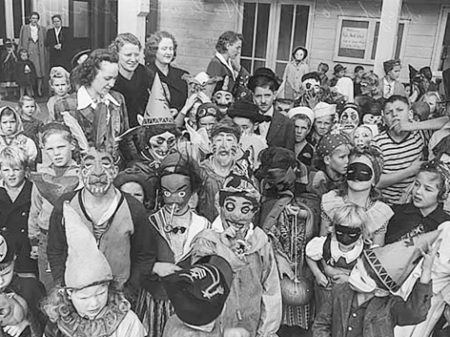
Most of the costumes were home-made including masks. While many dressed up in “traditional” costumes (e.g., witches, clowns, and pirates), others chose patriotic costumes such as Red Cross nurses, soldiers, and of course, Uncle Sam. Costumes and Halloween parties weren’t exclusively for the children. Parties were organized for the troops and movie theaters began to use the day to fill seats.
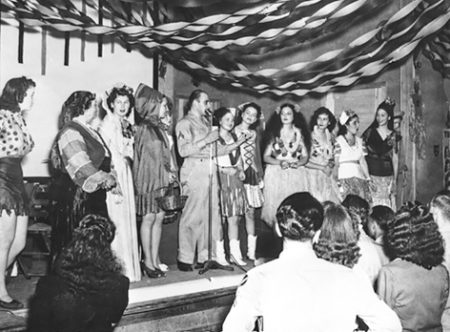
The ”trick” part of “trick or treat” did not go away. However, the magnitude of tricks diminished. Late night ringing of doorbells was discouraged as it deprived the sleep of people who were required to work the next morning at a war-time factory. Soaping windows, overturning garbage cans, and taking stuff continued but as time went on, the communities began to come down hard on the tricksters.

The biggest warning given to everyone concerning vandalism was that destructive activities would help Hitler, Mussolini, and Tojo.
KZ Sachsenhausen
Just north of Berlin is the town of Oranienburg where KZ Sachsenhausen was built in 1936. It was the first camp built after Heinrich Himmler turned the administration and full control of the concentration camps over to the Schutzstaffel (SS). Sachsenhausen became the center of the Nazi concentration camp system and was intended to be a model facility.
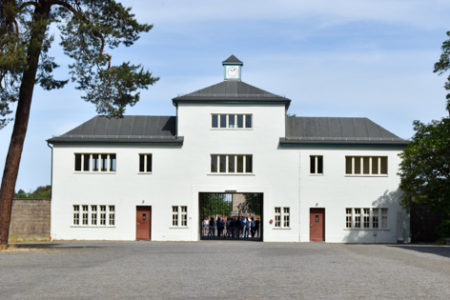
Bernard Kuiper’s triangular design prevented future expansion and subsequent camps were built in a more conventional style. Sachsenhausen consisted of the barracks area laid out in a fan-like pattern, a large roll-call area behind the main gate, guard towers with unobstructed views of the entire camp, and a gas chamber/crematorium. In 1941, an execution trench was built while two years later, “Station Z” was completed with its prisoner killing rooms, gas chamber, and four crematorium ovens.
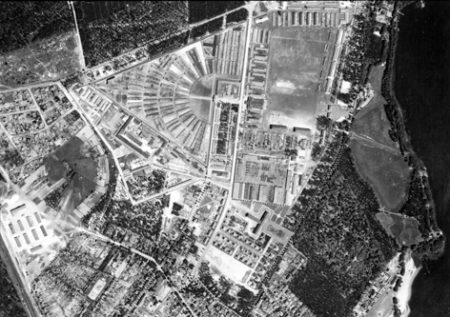
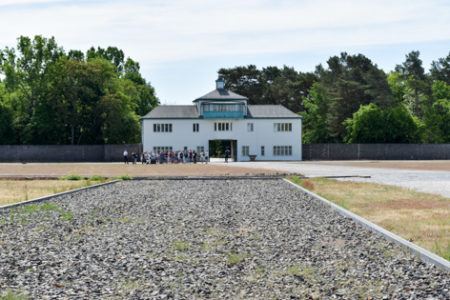
Sachsenhausen was intended to be a labor camp and eventually, had sixty-five subcamps. It was primarily used to imprison political prisoners and those arrested under Hitler’s Nacht und Nebel decree (click here to read the blog, Night and Fog). The main camp’s capacity was ten thousand inmates but by the end of 1943, the prisoner population reached 28,000. Soviet prisoners accounted for 35 percent of the population (32% were Soviet citizens and 3% were Soviet POWs) while Polish prisoners totaled twenty percent. Other prisoners were asocials (3%), Jehovah’s Witnesses (1%), and common criminals (7%). After 1943, the camp experienced explosive growth with the addition of numerous subcamps and the overall prisoner population grew to 66,000 inmates. Sachsenhausen segregated its “famous” prisoners such as Austria’s former chancellor, Kurt von Schuschnigg (1897−1977) and Stalin’s oldest son, Yakov Dzhugashvil (1907−1943).
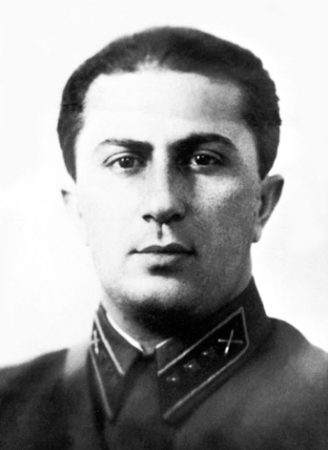
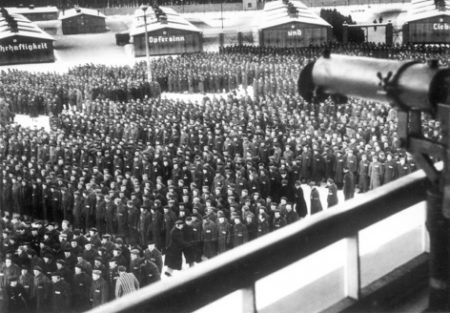
Despite being classified as a “labor” camp, Sachsenhausen was deadly. Prisoners worked in the Klinkerwerk, or “brickworks” building bricks for Albert Speer’s grand redesign of Berlin. Inmates assigned to the “shoe testing course” to test military footwear and the human medical experiments too often resulted in death. They were either worked to death or died from disease, malnutrition, or pneumonia. Outright executions took place by firing squads, hanging, or gas. Historians estimate between 40,000 and 50,000 people perished at Sachsenhausen.
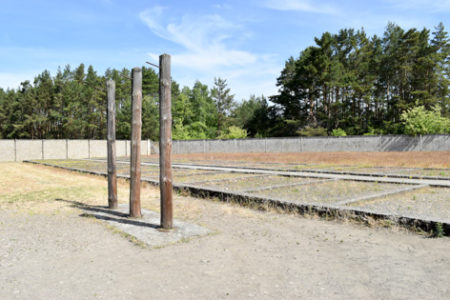
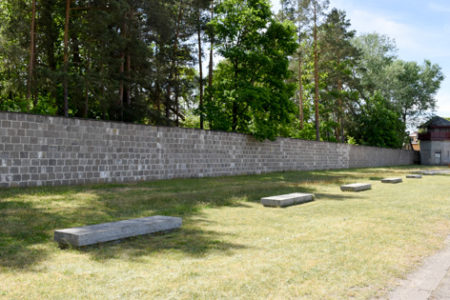
Sachsenhausen was not intended to imprison Jews. By December 1941, Jewish prisoners at Sachsenhausen totaled only 559 but by October 1942, Himmler ordered all Jews to be expelled from concentration camps located within Germany’s prewar borders. The remaining Jewish prisoners were sent to KZ Auschwitz II-Birkenau with the exception of a few who had the skills for either forgery or clock repair (i.e., processing watches stolen from Jews murdered at Auschwitz). Those with forgery skills were used in “Operation Bernhard.”
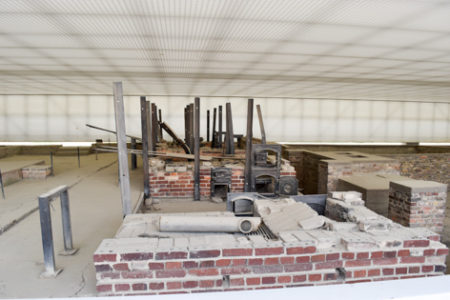
Operation Andreas
The idea for counterfeiting British currency resulted in the formation of “Operation Andreas” in September 1939. Although originated by the Finanzministerium, the operation was run by German Security Forces (RSHA) and its intelligence unit, the Sicherheitsdienst (SD). The German goal was to drop the counterfeit notes into England and destabilize the country’s economy. The assigned SD unit was led by SS-Sturmbannführer Alfred Naujocks (1911−1966) from its inception. That is, until Naujocks fell out of favor with RSHA boss, SS-Obergruppenführer Reinhard Heydrich (1904−1942). Before Heydrich was assassinated in June 1942, he closed down Naujocks’s forgery operation. However, during its two-year run, Naujocks and his men duplicated the paper used by the British to print pound notes. They also forged exact duplicate engraving plates and figured out the algorithm the British used to create the alpha-numeric serial codes on each £1 note.
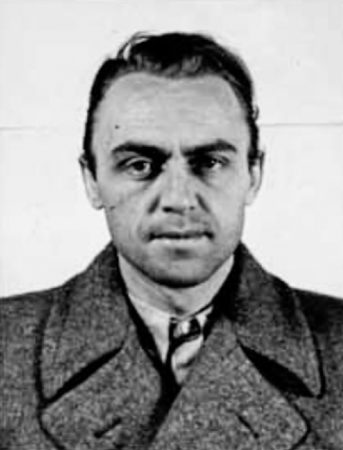
Operation Bernhard
SS-Sturmbannführer Bernhard Krüger (1904−1989) was in charge of Department VI F 4a, part of the SD-foreign branch in the RSHA. His responsibility was to oversee the creation of forged documents including passports. After the demise of “Operation Andreas,” the SD assigned Krüger to Sachsenhausen to start up a new forgery operation that became known as “Operation Bernhard.” Krüger recruited about 142 Jewish inmates with various skills and the SD transferred them from other concentration camps to Sachsenhausen.
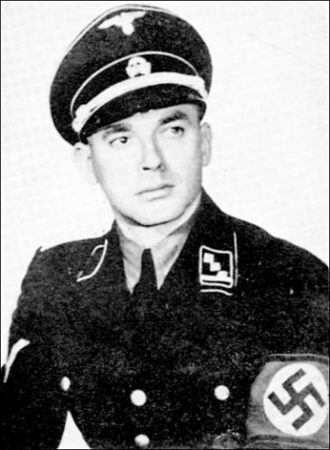
The selected inmates worked out of Blocks 18 & 19 in special barracks enmeshed with barbed wire. The unit was top-secret and Krüger saw to it that anyone who could compromise its secrecy was eliminated. Adolf Burger (1917−2016), a survivor of “Operation Bernhard,” once said “Major Krüger was in no way like Oskar Schindler. He was a murderer just like everyone else, six weeks before the war ended, he had six people shot just because they were sick. He couldn’t send them to the hospital in case they said something about the operation, so he killed them.” Despite being treated somewhat better than the other prisoners, the men of “Operation Bernhard” knew their lives depended on their ability to produce top quality forged currency notes. Burger said that he and the others were “dead men on holiday.”
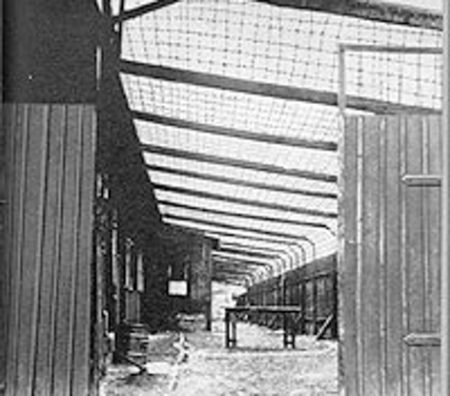
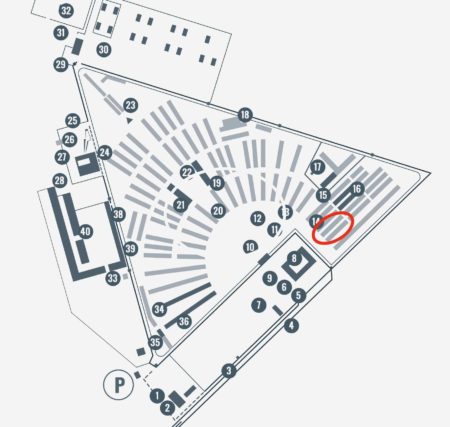
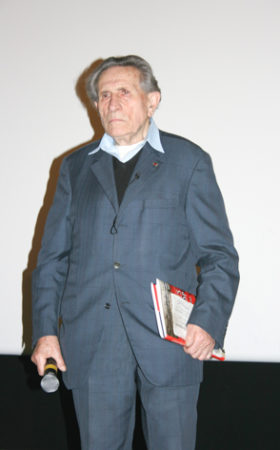
There were two, twelve-hour shifts each day. Six flatbed presses were used to print the bank notes with each press manned by two inmates. The production facility was divided into sections for cutting, aging, and sorting. Drying racks were set up and once dry, the sheets were cut into four individual notes and stacked. Inmates with dirty hands “massaged” the notes to deliberately “age” the paper. Additional techniques were employed to create a bank note that had been in circulation for some time. Once a week, Krüger personally packed up the week’s production, loaded it into his car, and drove the money to the SS foreign espionage headquarters in Berlin. One of the unanswered questions is, how much of the fake money was stolen during the disbursement process?
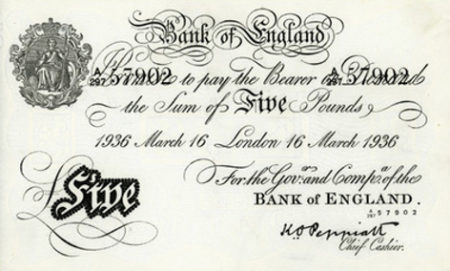
Oskar Stein was the manager of the operation and managed its bookkeeping. He kept a ledger of every note produced and, in the end, nine million separate notes had been recorded. Between 1942 and 1945, the inmates of “Operation Bernhard” produced bank notes totaling £132 million in total face value of the counterfeit currency. (This equates to about US$6.0 billion in current value.) Although £10, £20, and £50 notes were crafted, the primary denomination was the £5 note. (Krüger refused to forge £100 notes as he knew those would attract the most scrutiny.) Despite the proficiency and expertly crafted bank notes, none of the currency was ever dropped into England. (Perhaps by then the Luftwaffe did not have enough planes?) The Germans instead used the counterfeit money to pay their spies (click here to read the blog, The Double Cross System) and purchase raw materials and foreign currency. In May 1944, “Operation Bernhard” was ordered to begin counterfeiting American currency, but it proved a harder task due to paper issues and nothing came of it. It’s interesting that the Allies considered pursuing a similar strategy against Germany but abandoned the idea early on.
End of War
In early 1945 as the Allies were marching toward Berlin (from the west and east), the Germans dismantled their forgery operation at Sachsenhausen. The inmates and equipment were moved to Gusen, a subcamp of KZ Mauthausen and by early May, the prisoners were transported to Ebensee, another Mauthausen subcamp. Before he escaped, Krüeger gave the SS guards orders to execute the Jewish prisoners. Fortunately, due to a mix-up in orders, Krüger’s instructions were never carried out and as Allied forces approached, the guards fled.
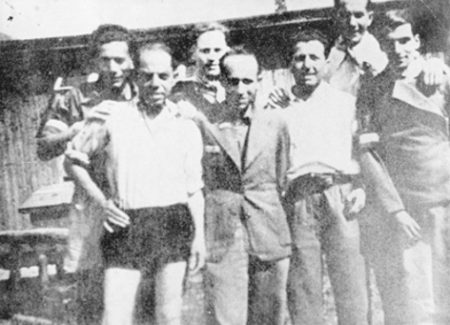
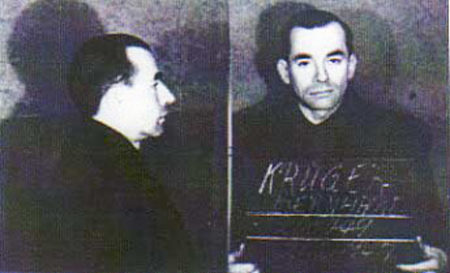
The remaining counterfeit currency was moved out of Sachsenhausen in watertight containers. The containers and some of the equipment were dumped into the Toplitzsee, an isolated and very deep lake located in the Austrian Alps near Salzburg. In 1959, some of the containers were recovered from the lake.

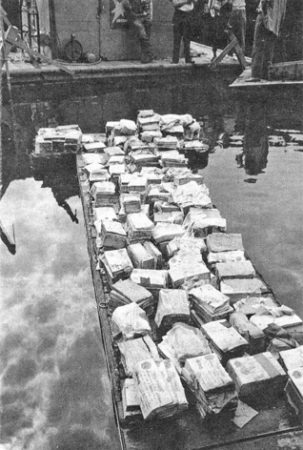
Post-War
After the war, the Bank of England admitted the currency produced by “Operation Bernhard” resulted in the best counterfeit notes ever printed. The government stopped releasing new notes and issued a new design with improved techniques to make it harder to counterfeit.
Next Blog: “Valkoinen Kuolema”
Correspondence and Commentary Policy
We welcome everyone to contact us either directly or through the individual blogs. Sandy and I review every piece of correspondence before it is approved to be published on the blog site. Our policy is to accept and publish comments that do not project hate, political, religious stances, or an attempt to solicit business (yeah, believe it or not, we do get that kind of stuff). Like many bloggers, we receive quite a bit of what is considered “Spam.” Those e-mails are immediately rejected without discussion.
Our blogs are written to inform our readers about history. We want to ensure discussions are kept within the boundary of historical facts and context without personal bias or prejudice.
We average about one e-mail every two days from our readers. We appreciate all communication because in many cases, it has led to friendships around the world.
★ Read and Learn More About Today’s Topic ★
Burger, Adolf. The Devil’s Workshop: A Memoir of the Nazi Counterfeiting Operation. London: Frontline Books, 2009. (First published in 1983 as “The Commando of Counterfeiters.”)
Burke, Bryan O. Nazi Counterfeiting of British Currency During World War II: Operation Andrew and Bernhard. San Bernardino: Book Store, 1988.
Columbia University. The Improbable Tale of Krueger’s Men. Columbia College Today, May/June 2007. Click here to read the article.
DePastino, Todd. How World War II Changed Halloween. Veterans Breakfast Club. Click here to read the article.
Malkin, Lawrence. Krueger’s Men: The Secret Nazi Counterfeit Plot and the Prisoners of Block 19. New York: Little, Brown and Company, 2006.
Megargee, Geoffrey P. (Editor). Encyclopedia of Camps and Ghettos 1933−1945, Volume 1, Part B. Bloomington: Indiana University Press and the United States Holocaust Memorial Museum, 2009.
Moorhouse, Roger. Berlin at War. New York: Basic Books, 2010.
Nachtstern, Moritz. Counterfeiter: How a Norwegian Jew Survived the Holocaust. Oxford: Osprey Publishing, 2008.
Pirie, Anthony. Operation Bernhard: The Story Behind the Greatest Forgery of All Time. New York: William Morrow (original edition published by Cassell & Co., 1961).
Suttill, Francis J. Prosper: Major Suttill’s French Resistance Network. Stroud UK: The History Press, 2018. (First published in 2014 as “Shadows in the Fog.”)
Wachsmann, Nikolaus. KL: A History of the Nazi Concentration Camps. New York: Farrar, Straus and Giroux, 2015.
Halloween on the Home Front. The National WWII Museum, 23 October 2020. Click here to read the article.
Two books listed above, The Devil’s Workshop and Counterfeiter, were written by survivors of “Operation Bernhard.”
Mr. Malkin has written an excellent account of the German counterfeiting operation. A good introduction to Mr. Malkin’s book can be found in the above referenced Columbia University publication.
Mr. Suttill is the son of Maj. Francis Suttill (1910−1945), a Special Operations Executive (SOE) agent who was arrested in Paris, tortured, and deported to Sachsenhausen in 1943. He was executed at the concentration camp on 23 March 1945. Mr. Suttill’s book is an account of his father’s role in the SOE as the leader of the Physician circuit. The book covers the deception and ultimate collapse of the circuit as well as the fate of its agents including the famous race car driver, William Charles Frederick Grover-Williams (1903−1945); click here to read the blog, The Racer, Spy and Erotic Model.
I point out Mr. Suttill’s book and his father’s story for a reason. Please refer below in the section “Someone is Commenting on Our Blogs” for an explanation.

Disclaimer:
There may be a chance that after we publish this particular blog, the video links associated with the blog are no longer accessible. We have no control over this. Many times, whoever posts the video has done so without the consent of the video’s owner. In some cases, it is likely that the content is deemed unsuitable by YouTube. We apologize if you have tried to access the link and you don’t get the expected results. Same goes for internet links.
What’s New With Sandy and Stew?
Several blogs ago, I mentioned how Sandy and I traveled back to Akron for my 50th high school reunion. As I look back, we were lucky to experience the “Age of Rock and Roll.” Perhaps more aptly the “Golden Age” depending on one’s perspective. One thing is certain, this year represents the 50th anniversaries of some incredible (and now classic) rock albums. Here are some of my favorites (in no particular order):
- The Dark Side of the Moon (Pink Floyd)
- Brothers and Sisters (The Allman Brothers)
- Goodbye Yellow Brick Road (Elton John)
- Band on the Run (Wings)
- Aladdin Sane (David Bowie)
- Quadrophenia (The Who)
- Aerosmith (Aerosmith)
- Houses of the Holy (Led Zeppelin)
- Piano Man (Billy Joel)
- Queen (Queen)
- Desperado (Eagles)
- Greetings from Asbury Park (Bruce Springsteen)
- The Joker (Steve Miller Band)
- Ooh La La (Faces)
- For Your Pleasure (Roxy Music)
- Larks’ Tongues in Aspic (King Crimson)
Hey hey, my my
Rock and roll can never die
There’s more to the picture
Than meets the eye.
Hey hey, my my
⏤ Neil Young & Crazy Horse
Rust Never Sleeps
1979
Thank you to all of you who subscribe to our bi-weekly blogs. It seems there isn’t a day that goes by where we don’t increase our readership. Please let your history buff friends and family members know about our blog site and blogs.
Someone Is Commenting On Our Blogs
Mr. Suttill and others are leading efforts to have a memorial plaque attached to the front of the building at 18, rue Mazagran in Paris. This was his father’s residence (on the second floor) and the place where Maj. Suttill was arrested by the Gestapo after returning to Paris from London in June 1943.
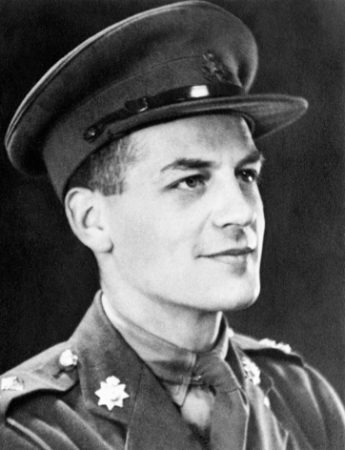
While I don’t yet have all the details concerning the project, I am encouraged that the building owner has tentatively agreed to allow the placement of the plaque. After the prolonged pandemic and other queued up projects, Willie Beauclerk and Libre Résistance are pushing this along the best they can. Dealing with the government can be slow and frustrating. However, Libre Résistance has a great track record for this type of project. I encourage all of you to visit Libre Résistance’s website and learn more about this organization that is dedicated to ensuring future generations do not forget the sacrifices made by the brave men and women of the SOE Section F who resisted the Nazis. Click here to visit the web-site.
I would like to thank Mr. Suttill for his kind permission to use images of his father for this blog. A future blog on Maj. Suttill (nom de guerre: Proper) and the SOE Physician circuit will be published in the future.
If there is a topic you’d like to see a blog written about, please don’t hesitate to contact me. I love hearing from you so keep those comments coming.
Shepherd.com is like wandering the aisles of your favorite bookstore.
Do you enjoy reading? Do you have a hard time finding the right book in the genre you enjoy? Well, Ben at Shepherd.com has come up with an amazing way to find that book.
Shepherd highlights an author (like me) and one of their books. The author is required to review five books in the same genre. So, if a reader is interested say in cooking, they can drill down and find specific books about cooking that have been reviewed by authors in that category. Very simple.
If you like to read, I highly recommend you visit Shepherd.com. If you do, please let me know what you think and I will forward Ben any suggestions or comments you might have.
Click here to visit Shepherd’s website.
Click the books to visit Stew’s bookshelf.
Check out Stew’s new bookshelf on the French Revolution.
Share This:
Follow Stew:

Find Stew’s books on Amazon and Apple Books.
Please note that we do not and will not take compensation from individuals or companies mentioned or promoted in the blogs.
 Walks Through History
Walks Through History
Copyright © 2023 Stew Ross



Stew and Sandy;
My wife and I just returned from a trip to France and Paris where we visited my wife’s sister’s grave in Montparnasse Cemetery. Her grave is immediately across the footpath from the joint grave of Simone de Beauvoir and Jean-Paul Sartre. How the Paris government allocates gravesites is a mystery. Some of them appear to be time-limited and then they are moved. Others are permanent. My wife seems to recall that she paid a fair amount for her sister to remain there permanently but she cannot recall exactly how this was done. Next time we go we will ask at the cemetery office.
Someday we will take a short drive to Punta Gorda and invite you to lunch. Your work is fantastic. We enjoy it very much.
Carl
Hi Carl, always good to hear from you! It is my understanding that there are three “subscriptions” one can purchase to obtain a grave site. There is the short-term, long-term, and perpetual license. Obviously, the price goes up as the length of the contract increases. Should the family not pay at time of renewal, the remains are removed, cremated, and placed in the cemetery’s ossuary. By all means, let us know and we can go to lunch. Would enjoy that very much. STEW